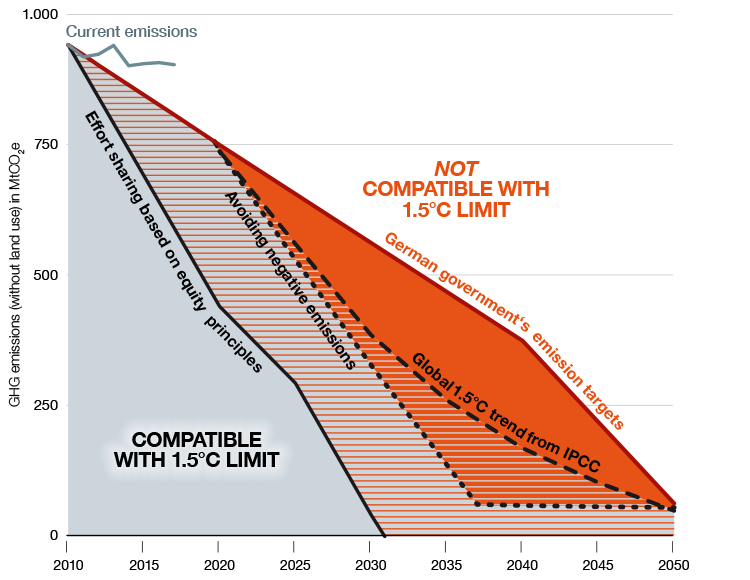This short analysis develops possible pathways that Germany should pursue to be compatible with the Paris Agreement, and compares those pathways to current national mitigation goals.
Note: The document is written in German, but contains an English summary.
Summary
The Paris Agreement on Climate Change signed in 2015 aims to limit global temperature rise well below 2°C, to pursue efforts to limit it to 1.5°C and to reach global net zero greenhouse gas (GHG) emissions in the second half of the century. This wording goes a long way from previous international political agreements.
Countries’ current measures are far from sufficient to meet these global goals. All countries are required to enhance their nationally determined climate goals. The German government is currently working on a Climate Protection Act, which would also enshrine national targets for reducing GHG emissions in the law.
The purpose of this brief analysis is to develop possible paths that Germany should aim for to be compatible with the long-term goals of the Paris Agreement and to compare the paths in relation to the current reduction targets of Germany.
The global target of 1.5°C can be distributed to countries in different ways. In this study we use three simplified approaches (Figure 1):
Figure 1. Summary of the various approaches to 1.5°C compatible paths for Germany
- Global 1.5°C trend from IPCC: Germany becomes CO2 neutral by the middle of the century. Emissions follow the global trend of the Intergovernmental Panel on Climate Change (IPCC) special report on 1.5°C. This approach is only 1.5°C compatible, if CO2 emissions are removed from the atmosphere during the course of the century (negative emissions).
- Avoiding negative emissions: Germany reduces its emissions to zero quickly enough so that the 1.5°C target can be achieved without removing greenhouse gases from the atmosphere.
- Effort sharing based on equity principles: The global greenhouse gas budget for 1.5°C is distributed among countries based on economic performance, historical responsibility and other criteria. This approach takes into account differences between countries and aims at distributing necessary mitigation efforts as equitably as possible.
We draw the following conclusions:
- The German government’s current climate targets are not compatible with 1.5°C: even under unrealistic assumptions – such as the removal of large quantities of greenhouse gas from the atmosphere – German climate targets fail to limit temperature rise to 1.5°C. If Germany follows the current target path of the federal government, we will emit 20 to 130% more greenhouse gases by the middle of the century than allowed for 1.5°C. The path of the Federal Government's Climate Mitigation Plan 2050 („Klimaschutzplan 2050“) to reach „extensive greenhouse gas neutrality by the middle of the century” (“weitgehende Treibhausgasneutralität bis Mitte des Jahrhunderts”) is alone insufficient to meet the 1.5°C limit. The emissions path is crucial; emissions need to decline rapidly between 2020 and 2040.
- Zero emissions by 2030 would be unambiguously in line with a 1.5°C compatible path: In order to be undeniably compatible with the 1.5°C limit and to live up to its global responsibility, Germany must already reduce its greenhouse gas emissions to zero by 2030. Germany would live up to its responsibilities and would not rely on having to remove greenhouse gases from the atmosphere. Even in the only conditionally 1.5°C compatible scenarios Germany’s greenhouse gas emissions must decrease by at least 70% compared to 1990 levels until 2030, and by at least 85% until 2040 compared to 1990 levels. In these scenarios Germany would not reduce emissions faster than poorer countries. It would also need to undergo efforts to remove emissions from the atmosphere. When taking into account particularly Germany’s historical emissions (and thus its historical responsibility), the greenhouse gas budget that Germany would be entitled to is already exhausted.
- Failure to meet the 2020 climate target jeopardizes holding the 1.5°C limit: By failing to meet the -40% target that was originally envisaged for 2020, Germany's emissions are considerably higher than originally planned. The resulting additional emissions account for 10% of Germany’s 1.5°C budget between 2010 and 2050. To keep the 1.5°C limit, such additional emissions would have to be saved at a later date through a steeper emission reduction path. Missing the target in 2020 makes it much harder to maintain a path compatible with the 1.5°C limit.





